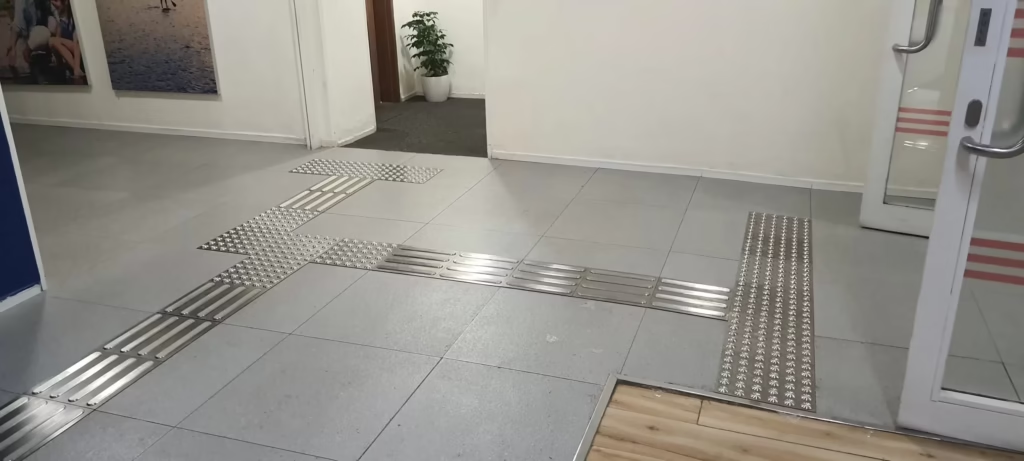Creating spaces that feel safe, welcoming, and accessible isn’t just about following regulations—it’s about designing with people in mind. When someone walks into a building, they shouldn’t have to think twice about whether they can navigate it safely. This is especially true for people with vision impairments, who rely heavily on built-in cues to guide their movement. One of the most important elements that help make this possible is the integration of tactile floor indicators.
These small, textured surfaces may seem simple, but they play a powerful role in shaping how inclusive a building truly is. Whether you manage a shopping centre, run a café, maintain a public facility, or oversee construction projects, understanding how integrated tactiles work can help you create safer, more intuitive spaces for everyone.
What Are Integrated Tactile Floor Indicators?
Integrated tactile floor indicators, often referred to as tactile ground surface indicators, are specially designed floor inserts designed to assist individuals with low vision. They consist of raised, textured patterns that can be felt underfoot or with a mobility cane. These cues alert individuals to changes in direction, hazards, drop-offs, such as stairways, or transitions, like the beginning of a ramp.
Unlike surface-mounted options, which sit above the existing floor, integrated tactiles are built directly into the flooring material itself. That means they are flush, secure, and durable—perfect for areas with high foot traffic or where aesthetics are a priority.
If you’ve ever stepped into a train station, airport, government building, or shopping mall, you’ve likely walked over these indicators without giving them a second thought. For many people, though, they are essential for moving around safely and confidently.
Why Buildings Need Them: Safety, Inclusion, and Compliance
Tactile indicators aren’t just functional—they’re meaningful. They send a message that a space was designed with the needs of real people in mind. Here are some of the key reasons they’re so important:
1. They protect people from hazards.
Imagine approaching a flight of stairs but only realizing you’re at the edge when you’ve already taken the first step. For someone with low vision, that scenario can be a real, everyday risk. Integrated tactiles provide early warning cues through textured patterns, signaling that a change in elevation or a hazard is ahead.
2. They enhance way-finding.
Linear (also called directional) tactile indicators help guide individuals through large or complex environments. Think of places like airports or hospital corridors—spaces where it’s easy to become disoriented. These cues offer a tactile “map” that can be followed safely.
3. They support inclusive design.
Inclusivity goes beyond meeting accessibility codes. It’s about creating spaces where people feel respected, valued, and considered. Integrated tactile indicators quietly support independence for people with vision impairments, giving them confidence to navigate without constant assistance.
4. They help you meet accessibility standards.
Many regions enforce detailed guidelines for building accessibility, often aligned with national disability standards. These guidelines outline when and where tactile indicators must be installed, the required pattern, and the necessary colour contrast. Following these ensures compliance while helping keep all building users safe.
Where You’ll Commonly Find Integrated Tactile Indicators
You might be surprised by how many industries and environments rely on tactile surfaces as a standard safety feature. Here are just a few examples:
Public Transport Hubs
Train stations, bus platforms, and ferry terminals utilize tactile elements extensively. They often appear right before platform edges to alert passengers that they’re nearing a drop-off.
Shopping Centres and Retail Stores
Retail spaces incorporate tactiles near stairs, escalators, travelators, and entryways—areas where foot traffic is constant and safety needs to be seamless.
Hospitals and Healthcare Facilities
Hospitals prioritise safety and accessibility. Integrated tactiles help patients, visitors, and staff navigate long hallways, multi-floor buildings, and high-use entrances.
Schools, Campuses, and Government Buildings
Educational institutions and public service buildings frequently incorporate tactile indicators to meet accessibility standards and support people of all ages.
Commercial Workplaces and Offices
More workplaces today are embracing inclusive design by adding tactiles near emergency exits, stairwells, or ramp entries.
Wherever they’re installed, integrated tactiles offer long-term durability and blend harmoniously with the building’s flooring, making them both functional and visually clean.
How Integrated Tactiles Improve Everyday Experiences
It’s easy to overlook just how many small details go into making a building feel safe. Something as simple as a textured surface can completely transform a person’s experience.
Imagine a busy office lobby during the morning rush. People move quickly, doors swing open, and distractions are everywhere. An employee with low vision walks in, relying on tactile cues to navigate around the lobby, find the elevator line, and safely make their way upstairs. Without tactile indicators, that same journey becomes filled with uncertainty.
Or picture a student navigating a university campus. Between stairs, ramps, crowded hallways, and multiple entry points, getting around can be overwhelming. Tactiles give them independence—no second-guessing or waiting for others to guide them.
These everyday situations highlight the significant impact that integrated tactile systems can have.
Choosing the Right Type of Tactile Indicator
When selecting tactile products, several factors come into play:
- Material durability: Many integrated tactiles are made from materials such as rubber, metal, or ceramic. Rubber options offer flexibility, safety, and a pleasant underfoot feel—great for commercial settings.
- Slip resistance: This is crucial in wet or high-traffic environments.
- Colour contrast: A clear visual contrast helps individuals with partial vision detect tactile surfaces more easily.
- Compliance: Ensuring the indicators meet your region’s accessibility standards is essential.
- Design compatibility: Integrated tactiles blend seamlessly with flooring, making them suitable for modern or design-driven spaces.
To explore examples of integrated tactile floor indicators that meet safety and accessibility requirements, visit here.
Why Inclusive Design Matters More Than Ever
In today’s world, accessibility isn’t an afterthought—it’s a fundamental part of ethical and thoughtful design. When buildings support people of all abilities, they become richer, more human, and more efficient spaces.
Designing with accessibility in mind also supports the broader movement toward universal design, a philosophy that focuses on creating environments that everyone can use without requiring adaptation. This concept is closely tied to accessible public infrastructure, a topic explored in depth in global resources, such as articles on public transport and inclusive environments.
Inclusive spaces:
- improve safety for all users
- reduce liability concerns for building owners
- support ageing populations
- enhance user experience
- promote equal access and dignity
Integrated tactile indicators may be small in size, but they represent a huge step toward creating environments where every person can move freely and safely.
Final Thoughts
Building safe and inclusive spaces isn’t about extravagant upgrades—it’s about paying attention to thoughtful details. Integrated tactile floor indicators are one of those details that quietly support safety, independence, and dignity for people with vision impairments. Whether you’re planning a renovation, designing a new building, or reviewing your current accessibility features, incorporating integrated tactiles is an investment in people.
By understanding what they do, where they’re used, and why they matter, you’re already taking a meaningful step toward creating a safer, more welcoming environment for everyone.






